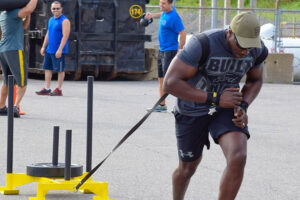Introduction
Functional fitness isn’t merely a fad for firefighters; it’s an essential aspect that could mean the difference between saving a life or the loss of a life. In a profession where physical fitness is essential to the job, keeping fit isn’t a choice; it’s a requirement. This guide is a compass for the brave souls who dare to risk their lives and explains the basic concepts of functional fitness and its specific application to firefighters’ specific requirements, as well as the ways that a lifestyle and exercise program rooted in functional fitness could improve overall health and performance.
Understanding Functional Fitness

Functional Fitness 101
Functional fitness is the term used to describe training that helps prepare the body for actual movements and sports. Contrary to traditional exercises that concentrate muscles, functional fitness is the training of several muscles to work in synergy. Functional fitness is a way to prepare for the challenges of firefighting that are never predictable. Tasks like lifting, carrying, pushing, and pulling are more demanding than physical strength.
Principles and movements for firefighters
Functional exercises aim to improve the strength and efficiency of your kinetic chain—how muscles and joints function during complex tasks. For firefighters, they are squats (a base to lift) as well as lunges (mimicking the climb up a stairway and carrying hoses with heavy weights) as well as burpees (for fast, full-body workouts).
Particular Fitness Needs for firefighters
Endurance the Engine of Firefighting
Firefighters are often required to work for long hours with little time for rest. It is vital to have endurance in the cardiovascular system for tasks like climbing ladders and carrying out ventilation tasks. Integrating high-intensity training (HIIT) along with steady-state cardio can help build the endurance required for the job.
Strength: The backbone of Physical Adaptation
It’s not just about pure power; it’s about endurance and preventing injury. Training for strength should cover both the lower and upper body, with a focus on compound exercises that imitate the actions of firefighters as well as core strength exercises to support the back and torso.
Mobility and Flexibility: Unsung Heroes
Firefighter jobs require extreme and rapid movements, which makes mobility and flexibility essential. The dynamic stretching and yoga benefits keep muscles elastic and ensure joint mobility. essential for injury prevention and rapid reaction times.
Nutrition and Recovery for Firefighters

Food is Fuel
Nutrition is the basis of performance. Firefighters require a balanced diet with healthy proteins and lean protein, as well as complex carbs and healthy fats. The timing of meals around shifts as well as supplementing electrolytes in stressful situations are essential.
Rest and Recuperation
Firefighters are often in stressful circumstances that could disrupt their sleeping routines. The importance of rest and sleep between shifts is crucial to recovery. Active recovery methods such as massage and foam rolling can help relieve the soreness of joints and boost flexibility.
Training programs for firefighters
Designing a program with a purpose
A firefighter’s exercise routine must be in line with how they work: varied, challenging, arduous, and unpredictable. Training for functional training should incorporate endurance, strength, and flexibility training in a manner that is reflective of the needs of firefighters.
Exercises and Routines
Examples of routines could include an entire body workout that focuses on compound movements, such as deadlifts, pushups, or kettlebell swings. In addition, adding specific drills for the job, such as hose carries and ladder raises, could help fine-tune your performance.
The benefits of Functional Fitness for Firefighters

On the Job and Beyond
The practice of functional fitness has benefits that go beyond the gym. It enhances your reflexes, improves the agility of your body, and increases concentration. These benefits don’t just improve abilities to fight fires but also lead to an overall healthier lifestyle.
A Protective Shield against Injuries
Through strengthening the core of the body and instabilizing and strengthening muscles, functional strength decreases the likelihood of acute injuries. It also increases endurance, which aids in recovering in the event of a firefighter being faced with a physically demanding situation.
Conclusion
The concept of functional fitness for firefighters isn’t a standardized idea. It’s about preparing to face the uncertainty of the job. This means focusing on the right moves and methods that boost endurance, boost strength, and improve agility. All while making sure that long-term fitness and injury prevention strategies are implemented. This guide offers a path for firefighters to improve and adapt when faced with the most challenging scenarios. It focuses on a philosophy that believes fitness is a base for preparation, which makes it a crucial instrument in a firefighter’s arsenal like any other piece of equipment.
